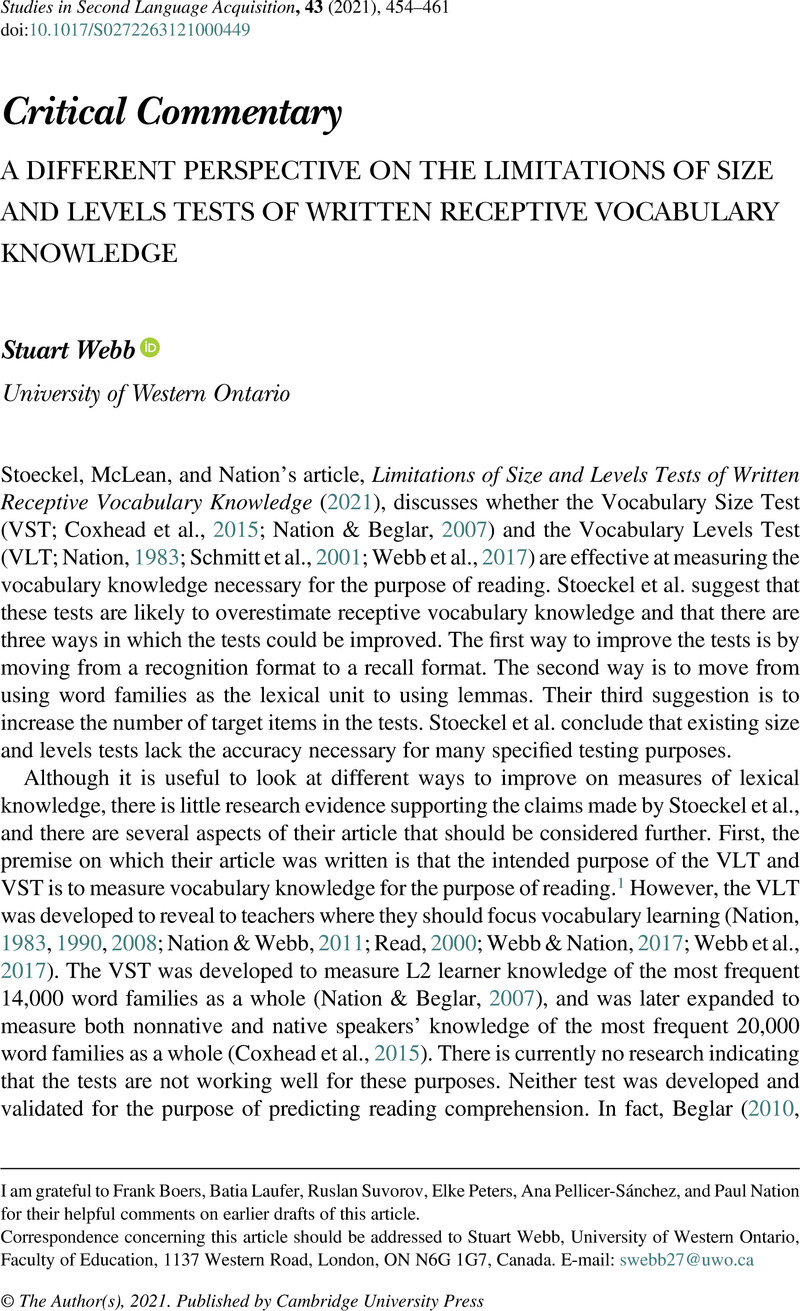Crossref Citations
This article has been cited by the following publications. This list is generated based on data provided by Crossref.
Webb, Stuart
2021.
WORD FAMILIES AND LEMMAS, NOT A REAL DILEMMA.
Studies in Second Language Acquisition,
Vol. 43,
Issue. 5,
p.
973.
Stewart, Jeffrey
Stoeckel, Tim
McLean, Stuart
Nation, Paul
and
Pinchbeck, Geoffrey G.
2021.
WHAT THE RESEARCH SHOWS ABOUT WRITTEN RECEPTIVE VOCABULARY TESTING.
Studies in Second Language Acquisition,
Vol. 43,
Issue. 2,
p.
462.
Ha, Hung Tan
2022.
Test Format and Local Dependence of Items Revisited: A Case of Two Vocabulary Levels Tests.
Frontiers in Psychology,
Vol. 12,
Issue. ,
Ha, Hung Tan
2022.
Issues in matching learners to their reading levels using receptive vocabulary knowledge – A closer look at the vocabulary levels tests and scoring methods.
Heliyon,
Vol. 8,
Issue. 8,
p.
e10244.
Read, John
2023.
Towards a new sophistication in vocabulary assessment.
Language Testing,
Vol. 40,
Issue. 1,
p.
40.
Stoeckel, Tim
Ishii, Tomoko
Kim, Young Ae
Ha, Hung Tan
Ho, Nam Thi Phuong
and
McLean, Stuart
2023.
A comparison of contextualized and non-contextualized meaning-recall vocabulary test formats.
Research Methods in Applied Linguistics,
Vol. 2,
Issue. 3,
p.
100075.
Finlayson, Natalie
Marsden, Emma
and
Anthony, Laurence
2023.
Introducing MultilingProfiler: An adaptable tool for analysing the vocabulary in French, German, and Spanish texts.
System,
Vol. 118,
Issue. ,
p.
103122.
Ncanywa, Thobeka
2023.
Eurocentric, Westernized, or Afrocentric curriculum in one university in the Eastern Cape: An entrepreneurship approach.
International Journal of Research in Business and Social Science (2147- 4478),
Vol. 12,
Issue. 10,
p.
113.
Zhang, Haiwei
Sun, Peng
Bianglae, Yaowaluk
and
Widiawati, Winda
2024.
The development of a Chinese vocabulary proficiency test (CVPT) for learners of Chinese as a second/foreign language .
Language Testing,
Vol. 41,
Issue. 2,
p.
412.
Komiya, Chihiro
and
McLean, Stuart
2024.
Which Type of Vocabulary-Knowledge Better Correlates with Reading-Comprehension, Meaning-Recognition or Meaning-Recall?.
RELC Journal,
Hamada, Akira
Hoshino, Yuko
Kojima, Masumi
Aizawa, Kazumi
Iso, Tatsuo
and
Kobayashi, Yuichiro
2024.
How many L2 word meanings can learners recall? A latent trait approach to vocabulary size estimation.
Applied Linguistics,
Fokin, Danil
Płużyczka, Monika
and
Golovin, Grigory
2025.
The Polish vocabulary size test: A novel adaptive test for receptive vocabulary assessment.
Behavior Research Methods,
Vol. 57,
Issue. 9,
Alamer, Abdullah
Al Khateeb, Ahmed
and
Alshabeb, Abdulrahman
2025.
The Creation and Validation of the Arabic Vocabulary Levels Test (Arabic-VLT).
Language Assessment Quarterly,
Vol. 22,
Issue. 2,
p.
117.
Ha, Hung Tan
Nguyen, Duyen Thi Bich
and
Stoeckel, Tim
2025.
A Comparison of Yen’s Q3 Coefficient and Rasch Testlet Modeling for Identifying Local Item Dependence: Evidence from Two Vocabulary Matching Tests.
Language Assessment Quarterly,
Vol. 22,
Issue. 1,
p.
56.
Norouzian, Reza
Jin, Zhouhan
and
Webb, Stuart
2025.
Increasing meta‐analytic quality: A multivariate multilevel meta‐analysis of note‐taking through exposure to L2 input.
The Modern Language Journal,
Vol. 109,
Issue. 1,
p.
171.
Kang, Hyeonah
and
Nicol, Janet
2025.
Effects of post-reading word-focused activities on L2 learners’ reading behavior and vocabulary learning: an eye-tracking study.
The Language Learning Journal,
p.
1.



